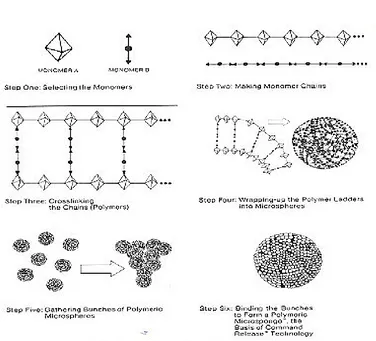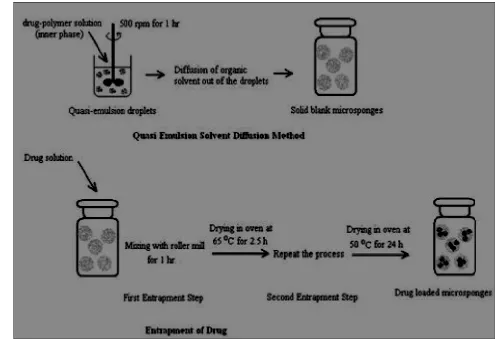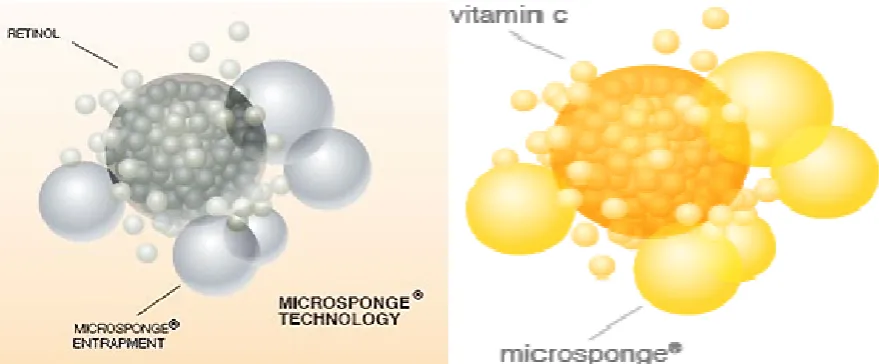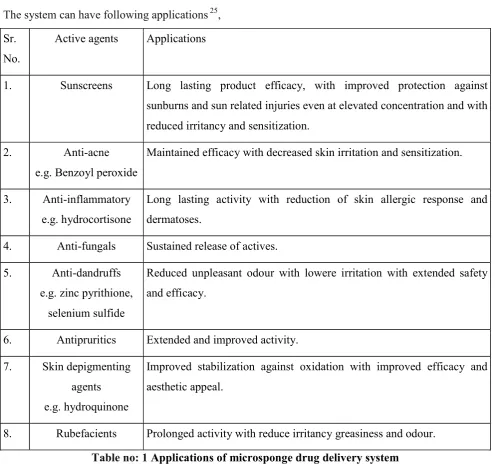THE MICROSPOGE DRUG DELIVERY SYSTEM: A OVERVIEW
Vikrant K ikam*1, Sachin B Somwanshi1, Ramdas T Dolas1, Vivekanand A Kashid1, Kiran B Dhamak2, Vinayak M Gaware2, Atul N Khadse2 and Kiran B Kotade3 1- Department of Pharmaceutics, College of Pharmacy, Chincholi, Sinnar, Nashik, M.S, 422 101. 2-Department of Pharmaceutical Chemistry, College of Pharmacy, Chincholi, Sinnar, Nashik, M.S, 422 101.
3-Department of Pharmacology, College of Pharmacy, Chincholi, Sinnar, Nashik, M.S, 422 101.
Corresponding author*:
Vikrant K ikam
Lecturer, Department of Pharmaceutics
College of Pharmacy, Chincholi, Sinnar, Nashik, M.S (422101) E-mail: vikrantnikam82@rediffmail.com
Summary
Microsponges are polymeric delivery systems composed of porous microspheres. They are tiny sponge-like spherical particles with a large porous surface. Moreover, they may enhance stability, reduce side effects and modify drug release favorably. Microsponge technology has many favorable characteristics, which make it a versatile drug delivery vehicle. Microsponge Systems are based on microscopic, polymer-based microspheres that can suspend or entrap a wide variety of substances, and can then be incorporated into a formulated product such as a gel, cream, liquid or powder. The outer surface is typically porous, allowing a sustained flow of substances out of the sphere. Microsponges are porous, polymeric microspheres that are used mostly for topical use and have recently been used for oral administration. Microsponges are designed to deliver a pharmaceutical active ingredient efficiently at the minimum dose and also to enhance stability, reduce side effects, and modify drug release.
Keywords:Tran dermal delivery system, Micro sponge Delivery System, Suspension polymerization,
Introduction
The drug delivery technology landscape has become highly competitive and rapidly evolving. More and more developments in delivery systems are being integrated to optimize the efficacy and cost-effectiveness of the therapy.1 Several predictable and reliable systems were developed for systemic drugs under the heading of transdermal delivery system (TDS) using the skin as portal of entry.2 It has
improved the efficacy and safety of many drugs that may be better administered through skin. But TDS
is not practical for delivery of materials whose final target is skin itself. Controlled release of drugs
onto the epidermis with assurance that the drug remains primarily localized and does not enter the
systemic circulation in significant amounts is an area of research that has only recently been addressed
with success. No efficient vehicles have been developed for controlled and localized delivery of drugs
into the stratum corneum and underlying skin layers and not beyond the epidermis. Application of
topical drugs suffers many problems such as ointments, which are often aesthetically unappealing,
greasiness, stickiness etc. that often results into lack of patient compliance. These vehicles require high
concentrations of active agents for effective therapy because of their low efficiency of delivery system,
resulting into irritation and allergic reactions in significant users. Other drawbacks of topical
formulations are uncontrolled evaporation of active ingredient, unpleasant odour and potential
incompatibility of drugs with the vehicles. Thus the need exists for system to maximize amount of
time that an active ingredient is present either on skin surface or with in the epidermis, while
minimizing its transdermal penetration into the body. The microsponge delivery system fulfills these
requirements.
A Microsponge Delivery System (MDS) is patented, highly cross-linked, porous, polymeric
microspheres polymeric system consisting of porous microspheres that can entrap wide range of actives
and then release them onto the skin over a time and in response to trigger. 3 It is a unique technology
for the controlled release of topical agents and consists of microporous beads, typically 10-25 microns
in diameter, loaded with active agent. When applied to the skin, the MDS releases its active ingredient
on a time mode and also in response to other stimuli (rubbing, temperature, pH, etc). MDS technology
is being used in cosmetics, over-the-counter (OTC) skin care, sunscreens and prescription products.
Delivery system comprised of a polymeric bead having network of pores with an active ingredient held
within was developed to provide controlled release of the active ingredients whose final target is skin
itself.4 The system was employed for the improvement of performance of topically applied drugs.5, 6, 7
The common methods of formulation remains same; the incorporation of the active substance at its
diffusion of the stratum corneum. and liposomes. Microcapsules cannot usually control the release rate
of actives. Once the wall is ruptured the actives contained with in microcapsules will be released.
Liposomes suffer from lower payload, difficult formulation, limited chemical stability and microbial
instability. While microsponge system in contrast to the above systems are stable over range of pH 1 to
11, temperature up to 130oC; compatible with most vehicles and ingredients; self sterilizing as average
pore size is 0.25µm where bacteria cannot penetrate; higher payload (50 to 60%), still free flowing and
can be cost effective. Most liquid or soluble ingredients can be entrapped in the particles. Actives that
can be entrapped in microsponges must meet following requirements,
• It should be either fully miscible in monomer or capable of being made miscible by addition of
small amount of a water immiscible solvent.
• It should be water immiscible or at most only slightly soluble.
• It should be inert to monomers.
• It should be stable in contact with polymerization catalyst and conditions of polymerization
Release can be controlled through diffusion or other triggers such as moisture, pH, friction, or
temperature. This release technology is available for absorbent materials or to enhance product
aesthetics. Microsponge delivery system can be incorporated into conventional dosage forms such as
creams, lotions, gels, ointments, and powder and share a broad package of benefits. Systems can and
improve its formulation flexibility.
PREPARATIO OF MICROSPOGES
Drug loading in microsponges can take place in two ways, one-step process or by two-step process;
based on physico-chemical properties of drug to be loaded. If the drug is typically an inert non-polar
material, will create the porous structure it is called porogen. Porogen drug, which neither hinders the
polymerization nor become activated by it and stable to free radicals is entrapped with one-step
process.
• Liquid-liquid suspension polymerization:
Microsponges are conveniently prepared by liquid-liquid suspension polymerization. Polymerization of
styrene or methyl methacrylate is carried out in round bottom flask. A solution of non-polar drug is
made in the monomer, to which aqueous phase, usually containing surfactant and dispersant to promote
suspension is added. Polymerization is effected, once suspension with the discrete droplets of the
Figure 1: Reaction Vessel for Microsponge Preparation By Liquid-Liquid Suspension Polymerization
When the drug is sensitive to the polymerization conditions, two-step process is used. The
polymerization is performed using substitute porogen and is replaced by the functional substance under
mild experimental conditions 8.
• Quasi-emulsion solvent diffusion
As explained in Figure 3 the microsponges can also be prepared by quasi-emulsion
solvent diffusion method using the different polymer amounts. The processing flow chart is presented
in Fig. 1a. To prepare the inner phase, Eudragit RS 100 was dissolved in ethyl alcohol. Then, drug can
be then added to solution and dissolved under ultrasonication at 35 oC. The inner phase was poured into
the PVA solution in water (outer phase). Following 60 min of stirring, the mixture is filtered to separate
the microsponges. The microsponges are dried in an air-heated oven at 40 oC for 12 h and weighed to
determine production yield (PY). 9
PHYSICAL CHARACTERIZATIO OF MICROSPOGES
• Particle size determination 10
Free-flowing powders with fine aesthetic attributes are possible to obtain by controlling the size of particles during polymerization. Particle size analysis of loaded and unloaded microsponges can be performed by laser light diffractometry or any other suitable method. The values (d50) can be expressed for all formulations as mean size range. Cumulative percentage drug release from microsponges of different particle size will be plotted against time to study effect of particle size on drug release. Particles larger than 30 µm can impart gritty feeling and hence particles of sizes between 10 and 25 µm are preferred to use in final topical formulation.
• Morphology and Surface topography of microsponges
For morphology and surface topography, prepared microsponges can be coated with gold–palladium under an argon atmosphere at room temperature and then the surface morphology of the microsponges can be studied by scanning electron microscopy (SEM). SEM of a fractured microsponge particle can also be taken to illustrate its ultrastructure 11.
• Determination of loading efficiency and production yield
The loading efficiency (%) of the microsponges can be calculated according to the following equation:
The production yield of the microparticles can be determined by calculating
accurately the initial weight of the raw materials and the last weight of the
microsponge obtained.12
• Determination of true density
The true density of microparticles and BPO was measured using an ultra-pycnometer under helium gas
and was calculated from a mean of repeated determinations.
• Characterization of pore structure
Pore volume and diameter are vital in controlling the intensity and duration
from microsponges into the vehicle in which the material is dispersed. Mercury intrusion porosimetry
can be employed to study effect of pore diameter and volume with rate of drug release from
microsponges. 13
Porosity parameters of microsponges such as intrusion–extrusion isotherms, pore size distribution, total
pore surface area, average pore diameters, shape and morphology of the pores, bulk and apparent
density can be determined by using mercury intrusion porosimetry. Incremental intrusion volumes can
be plotted against pore diameters that represented pore size distributions.
• Compatibility studies
Compatibility of drug with reaction adjuncts can be studied by thin layer chromatography (TLC) and
Fourier Transform Infra-red spectroscopy (FT-IR). Effect of polymerization on crystallinity of the drug
can be studied by powder X-ray diffraction (XRD) and Differential Scanning Colorimetry (DSC). 16, 17,
18
For DSC approximately 5 mg samples can be accurately weighed into aluminum pans and sealed and
can be run at a heating rate of 15oC/min over a temperature range 25–430oC in atmosphere of nitrogen.
• Polymer/ Monomer composition
Factors such as microsphere size, drug loading, and polymer composition govern the drug release from
microspheres. 19, 20 Polymer composition of the MDS can affect partition coefficient of the entrapped
drug between the vehicle and the microsponge system and hence have direct influence on the release
rate of entrapped drug. Release of drug from microsponge systems of different polymer
compositions can be studied by plotting cumulative % drug release against time.
Release rate and total amount of drug released from the system composed of methyl methacrylate/
ethylene glycol dimethacrylate is slower than styrene/ divinyl benzene system.
Selection of monomer is dictated both by characteristics of active ingredient
ultimately to be entrapped and by the vehicle into which it will be dispersed.
• Resiliency
Resiliency (visco elasticproperties) of microsponges can be modified to produce beadlets that is softer
or firmer according to the needs of the final formulation. Increased cross-linking tends to slow down
the rate of release. Hence resiliency of microsponges will be studied and optimized as per the
RELEASE EVALUATIOS
• Dissolution tests
Dissolution profile of microsponges can be studied by use of dissolution apparatus
USP XXIII with a modified basket consisted of 5µm stainless steel mesh. The speed of the rotation is
150 rpm. The dissolution medium is selected while considering solubility of actives to ensure sink
conditions. Samples from the dissolution medium can be analysed by suitable analytical method at
various intervals.
• Release mechanisms 21
By proper manipulation of the aforementioned programmable parameters, microsponges can be
designed to release given amount of active ingredients over time in response to one or more external
triggers. 1. Pressure: Rubbing/ pressure applied can release active ingredient from microsponges onto
skin.
2. Temperature change: Some entrapped actives can be too viscous at room temperature to flow
spontaneously from microsponges onto the skin. Increased in skin temperature can result in an
increased flow rate and hence release.
3. Solubility: Microsponges loaded with water-soluble ingredients like anti-prespirants and antiseptics
will release the ingredient in the presence of water. The release can also be activated by diffusion
taking into consideration the partition coefficient of the ingredient between the microsponges and the
outside system.
Safety considerations 22, 23
Safety substantiation of microsponges can be confirmed by skin irritation studies in
rabbits; eye irritation studies in rabbits; oral toxicity studies in rats; mutagenicity in bacteria and
allergenicity in guinea pigs.
FORMULATIO COSIDERATIOS
Actives entrapped in MDS can then be incorporated into many products such as creams, lotions,
powders and soaps. When formulating the vehicle, certain considerations are taken into account in
order to achieve desired product characteristics.
1. The solubility of actives in the vehicle must be limited. Otherwise
the vehicle will deplete the microsponges before the application.
2. To avoid cosmetic problems; not more than 10 to 12% w/w microsponges
3. Polymer design and payload of the microsponges for the active must
be optimized for required release rate for given time period.
There remains equilibrium between microsponge and vehicle and microsponge releases drug in
response to the depletion of drug concentration in the vehicle. Drug concentration in the vehicle is
depleted by absorption of the drug into skin. Hence continuous and steady release of actives onto the
skin is accomplished with this system. Drug release from the topical semisolid formulation can be
studied by using Franz-type static diffusion cells. 24
Figure 4: Retinol & Vitamin C Microsponge
APPLICATIOS OF MICROSPOGE SYSTEMS
Microsponges are porous, polymeric micro spheres that are used mostly for topical and recently for oral
administration. It offers the formulator a range of alternatives to develop drug and cosmetic products.
Microsponges are designed to deliver a pharmaceutical active ingredient efficiently at the minimum
The system can have following applications 25,
Sr. No.
Active agents Applications
1. Sunscreens Long lasting product efficacy, with improved protection against sunburns and sun related injuries even at elevated concentration and with reduced irritancy and sensitization.
2. Anti-acne e.g. Benzoyl peroxide
Maintained efficacy with decreased skin irritation and sensitization.
3. Anti-inflammatory e.g. hydrocortisone
Long lasting activity with reduction of skin allergic response and dermatoses.
4. Anti-fungals Sustained release of actives.
5. Anti-dandruffs e.g. zinc pyrithione,
selenium sulfide
Reduced unpleasant odour with lowere irritation with extended safety and efficacy.
6. Antipruritics Extended and improved activity.
7. Skin depigmenting agents e.g. hydroquinone
Improved stabilization against oxidation with improved efficacy and aesthetic appeal.
8. Rubefacients Prolonged activity with reduce irritancy greasiness and odour.
Table no: 1 Applications of microsponge drug delivery system
MARKETED FORMULATIO USIG THE MDS
Microsponge delivery systems are used to enhance the safety, effectiveness and aesthetic quality of
topical prescription, over-the-counter ("OTC") and personal care products. Products under development
or in the marketplace utilize the Topical Microsponge systems in three primary ways;
• As reservoirs releasing active ingredients over an extended period of time,
• As receptacles for absorbing undesirable substances, such as excess skin oils, or
The resulting benefits include extended efficacy, reduced skin irritation, cosmetic elegance,
formulation flexibility and improved product stability. The fundamental appeal of the Microsponge
technology stems from the difficulty experienced with conventional topical formulations in releasing
active ingredients over an extended period of time. Cosmetics and skin care preparations are intended
to work only on the outer layers of the skin. Yet, the typical active ingredient in conventional products
is present in a relatively high concentration and, when applied to the skin, may be rapidly absorbed.
The common result is over-medication, followed by a period of under-medication until the next
application. Rashes and more serious side effects can occur when the active ingredients rapidly
penetrate below the skin's surface. Microsponge technology is designed to allow a prolonged rate of
release of the active ingredients, thereby offering potential reduction in the side effects while
maintaining the therapeutic efficacy. Marketed formulation using the MDS includes Dermatological
products (APS defined ethical dermatology products as prescription and non-prescription drugs that are promoted primarily through the medical profession for the prevention and treatment of skin problems
or diseases). Several ethical dermatology products approved by US FDA, OTC and personal care
products are sold in the United States. Results from various human clinical studies reaffirmed that the
technology offers the potential to reduce the drug side effects, maintain the therapeutic efficacy and
potentially increase patient compliance with the treatment regimen.
Conclusion
The MDS which was originally developed for topical delivery of drugs can also be used for controlled
oral delivery of drugs using bioerodible polymers, especially for colon specific delivery. It provides a
wide range of formulating advantages. Liquids can be transformed into free flowing powders.
Formulations can be developed with otherwise incompatible ingredients with prolonged stability
without use of preservatives. Safety of the irritating and sensitizing drugs can be increased and
programmed release can control the amount of drug release to the targeted site.
References
1. Chowdary K. P. R., and Rao Y. S., Mucoadhesive Microspheres for Controlled Drug Delivery, Biol. Pharm. Bull., 2004;27:1717-1724.
2. Kydonieus A. F. and Berner B., Transdermal Deliveryof Drugs, CRC Press, Boca Raton ,1987.
4. Won R., sep. 1987, United States Patent No. 4,690,825, Method for delivering an active ingredient by controlled time release utilizing a novel delivery vehicle, which can be prepared by a process utilizing the active ingredient as a porogen.
5. Embil, K., Nacht, S., The microspongedelivery system (MDS): a topical delivery system with reduced irritancy incorporating multiple triggering mechanisms for the release of actives. J. Microencapsul. 1992;13: 575–588.
6. .L. Delattre and I. Delneuville, Biopharmaceutical aspects of the formulation of dermatological vehicles, Journal of the European Academy of Dermatology and Venereology, 1995;5: 70.
7. Weiss R., Drug Delivery in the Space Age, Consultant Pharmacist, 1989; 4: 15-17, 19, 23. 8. Won R., United States Patent No. 5,145,675 Two step method for preparation of controlled
release formulations.
9. .M. Jelvehgari, M.R. Siahi-Shadbad, S. Azarmi, Gary P. Martin, Ali Nokhodchi The microsponge delivery system of benzoyl peroxide: Preparation, characterization and release studies, International Journal of Pharmaceutics, 2006; 308:124–132.
10.MartinA., Swarbrick J. & Cammarrata A. In: Physical Pharmacy- Physical Chemical Principles in Pharmaceutical Sciences 1991;3: 527.
11. EmanueleA. D., Dinarvand R., Preparation, Characterization and Drug Release from Thermo responsive Microspheres, International Journal of Pharmaceutics , 1995:237-242.
12.Kilicarslan, M., Baykara, T., The effect of the drug/polymer ratio on the propertiesof Verapamil HCl loaded microspheres. Int. J. Pharm. 2003;252:99–109.
13.Poresizer Model No. 9310, Micromeritics Instrument Corp., Nor-cross , Georgia .
14. Washburn, E.W., Note on a method of determining the distribution of pore sizes in a porous material. Proc. Natl. Acad. Sci. U.S.A.1921; 7:115–116.
15. Orr Jr., C., Application of mercury penetration to material analysis. Powder Technol. 1969;3: 117–123.
16.Kawashima Y, Niwa T, Takeuchi H, Hino T, Itoh Y, Furuyama S. Characterization of polymorphs of tranilast anhydrate and tranilast monohydrate when crystallized by two solvent change spherical crystallization techniques. J. Pharm. Sci. 1991; 81:472-478.
17. Bodmeier R, Chen H. Preparation and characterization of microspheres containing the anti-inflammatory agents, indomethacin, ibu-profen, and ketoprofen. J.Control. Release. 1989; 10:167-175.
18. Jones DS, Pearce KJ. Investigation of the effects of some process variables on, microencapsulation of propranolol HCl by solvent evaporation method. Int. J. Pharm. 1995; 118: 99-205.
19.Wakiyama N, Juni K, Nakano M. Preparation and evaluation in vitro of polylactic acid microspheres containing local anesthetic. Chem. Pharm. Bull. ( Tokyo ). 1981; 29:3363-3368. 20. Barkai A, Pathak V, Benita S. Polyacrylate (Eudragit retard) microspheres for oral controlled
release of nifedipine. I. Formulation design and process
optimization. Drug Dev. Ind. Pharm. 1990; 16:2057-2075.
21.Shah V.P., Determination of In-vitro Release from Hydrocortisone Creams. International Journal of Pharmaceutics. 1989; 53: 53-59.
23.Draize J.H., Woodard J & Calvary H.O., Methods for the Study of Irritation & Toxicity of Substances Applied Topically to the Skin & Mucous Membranes. Journal of Pharmacology & Experimental Therapeutics. 1944; 82: 377-389.
24. Franz T. J., Percutaneous absorption. On the relevance of in vitro date. J. Invest. Dermatol., 1975; 45: 498-503.
25.Khopade A. J., Jain Sanjay, Jain N.K., March “The Microsponge”; Eastern Pharmacist, 1996;49-53.
26.Yazici, E.; Kas, H. S.; Hincal, A. A., Microsponges, Farmasotik Bilimler Dergisi (Turkey), 1994; 19: 121-128.
27.Wester R., Patel R., Natch S., Leyden J., Melendres J., Maibach H., Controlled release of benzoyl peroxide from a porous microsphere polymeric system can reduce topical irritancy, J. Am. Acad. Derm., 1991; 24: 720-726.



